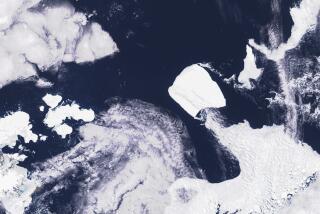An unexpected lesson in Antarctic ice melt
It’s called calving, and it occurs when enormous chunks of ice burst free from glaciers or floating ice shelves and drop into the sea with an explosive, heart-stopping crash.
This process, which produces icebergs, has long been viewed as the primary mechanism for ice loss along the continent of Antarctica.
Now however, scientists say calving is only half the story.
In what is being described as the first comprehensive survey of all Antarctic ice shelves, a study to be published Friday in the journal Science reports that 55% of the ice loss is due to melting at the base of these vast ice sheets.
“We find that iceberg calving is not the dominant process of ice removal,” wrote Eric Rignot, a professor of earth system science at UC Irvine. “Ice shelves melt mostly from the bottom before they even form icebergs.”
Ice shelves are permanent sheets of floating ice that cling to land masses. They are found mostly in the Antarctic.
The study’s conclusions were based on ice thickness data collected by NASA’s Operation Ice Bridge, a six-year program that uses satellites, aircraft, radio echo sounding and other means to survey ice cover on both of Earth’s poles.
Researchers found that basal melting in Antarctic ice shelves accounted for roughly 1,325 gigatons of melted ice per year, while calving accounted for 1,089 gigatons.
That melting however does not translate to a direct loss of Antarctic ice. Many ice shelves are near equilibrium, the authors wrote. Others were gaining more ice while others were losing overall ice.
Due to a number of factors, including geography and wind patterns, the North and South poles are experiencing opposite trends in sea ice.
The extent of summer sea ice in the Arctic has declined significantly over the last 30 years, while sea ice cover has been growing in Antarctica. However, the growth of sea ice in the south has not been as large as the loss of sea ice in the north.
Return to Science Now blog.
Follow me on Twitter @montemorin







